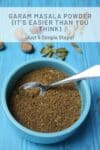This Garam Masala Powder combines cumin, coriander, black pepper, cardamom, and cinnamon to create the classic Indian seasoning that imparts a warm, sweet flavor to a variety of dishes. Use this Garam Masala Spice blend to season chicken, lamb, and fish for a hint of warm Indian flavor.
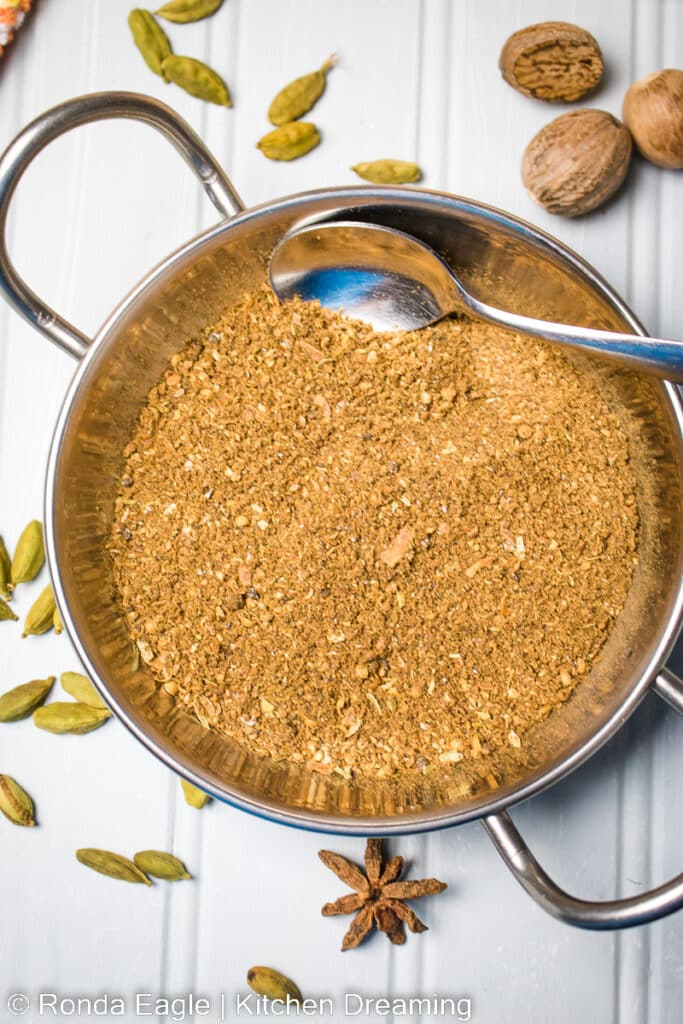
What is Garam Masala?
Garam Masala Powder is an aromatic blend of spices that is very popular in authentic Indian recipes. Maybe you are wondering, “What does Garam Masala mean in English?”. Garam Masala is the Hindi term meaning “warm mixture” of spices. This dry-roasted blend of spices can be used in a variety of dishes and is most often used as a base to which more spices are added like tandoori chicken, for instance.
The “warm mixture” of spices refers to the metabolic warming and not the “hot spicy heat” for which Indian food has become well known. It seems there is some science behind the fact that the warming spices do raise your body temperature making you feel warm and even sweat while you eat Indian food! All joking aside, Indian food does not have to be super spicy-hot either. When you make your own seasoning blends at home, you can easily adjust the heat level to a level of spice you enjoy.
When you first get started in Indian cooking, you might notice that the splice blends call for a lot of seasonings you may not have on hand. Purchasing them in the grocery store can be quite costly too, that is if they even carry all the exotic spices you need. You’d be surprised though, with the worldwide boom in ethnic cooking, most stores are really trying to amp up their spice aisles. So be sure to check them out.
Even so, your best bet is to head up to the local Indian grocery store. You will find their prices to be much more affordable and they will have all the ingredients you need on hand and all in one place. If your store is anything like mine, the gentleman behind the counter is more than happy to point you in the right direction.
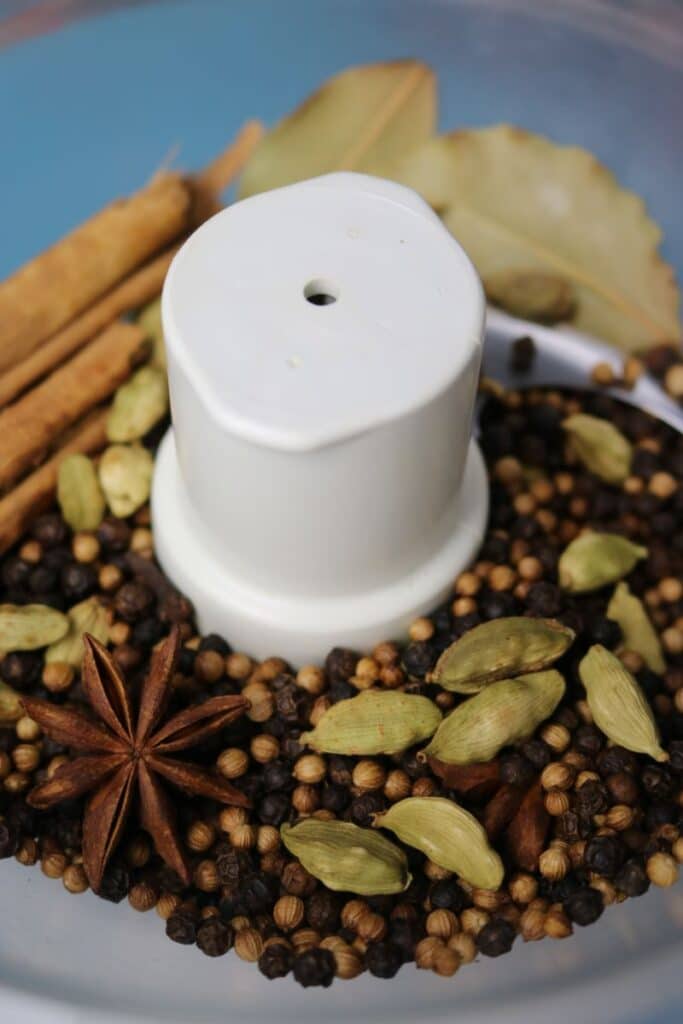
What does Garam Masala Taste Like?
Garam masala is a blend of spices commonly used in Indian and other South Asian cuisines. Its flavor is warm, aromatic, and complex, with sweet and savory notes.
The exact flavor profile of garam masala can vary depending on the blend of spices used and the quantities of each spice. However, some common ingredients in garam masala blends include cinnamon, cardamom, cumin, coriander, black pepper, cloves, and nutmeg.
The cinnamon in garam masala adds a sweet, warm flavor, while the cardamom provides a floral and slightly minty note. Cumin and coriander contribute earthy, nutty flavors, and black pepper adds a subtle spiciness. Cloves provide a slightly bitter, pungent taste, and nutmeg adds a warm, slightly sweet flavor.
Overall, garam masala adds depth and complexity to dishes, and its warm, aromatic flavor can be used to enhance a wide variety of foods, from curries and stews to roasted vegetables and meat dishes.
Where to Buy Garam Masala Powder
If a trip to the Indian spice market to make this homemade garam masala doesn’t appeal to you, you can always opt for Amazon. They have everything you need to make this aromatic spice blend. If you prefer a pre-packaged Garam Masala spice mix [affiliate link], this one comes highly recommended and is a non-GMO-certified brand that I know and trust. The Amazon price is also very close to what I’ve seen in the brick-and-mortar storefront as well. When selecting a pre-packaged blend, look for one that sticks to the traditional ingredients listed in this recipe.
Garam Masala Ingredients And Tools
Garam masala powder recipes vary widely depending on the area of India you’re in and also between regional and family recipes. No two recipes are exactly alike as individuals and families adjust the seasoning to accommodate their personal preferences. This garam masala recipe incorporates the spices you will find in many of the traditional blends found on the market today. You can make it your own by adding a pinch or so more of the flavors you enjoy. This recipe, like any, is totally customizable and we encourage you to do just that.
What’s in Garam Masala?
This is a tough question. As we’ve mentioned before, Garam masala powder mixes vary widely but some common ingredients found in Indian Garam Masala blends are listed below. The basic spices are the five listed below. Then optional spices are listed below and are added in amounts according to individual tastes.
The Basic Spices
- Cumin – Rich and hearty, earthy and warm, with a hint of citrus, Cumin adds instant depth to any dish.
- Black Peppercorns – Black pepper enhances the flavor of meat, gives a spicy bite to soups and stews, and brings layers of additional flavor to vegetables.
- Coriander – The flavor of coriander is warm and sweet with a hint of lemon, aromatic coriander is used to flavor sweet and savory recipes.
- Cinnamon – One of the world’s oldest spices, cinnamon is also one of the most popular. It brings deep, warm sweetness to the dishes.
- Green Cardamom pods – green cardamom has a complex mix of sweet, peppery, floral flavors used in both savory and sweet dishes and teas. Cardamom is known as the Queen of Spices because of its many uses, both medicinal and as an ingredient in cuisines all over the world. For some, cardamom can have an overpowering floral note, so it’s best to start with a small amount and flavor adjust as you go.
Optional Additional Spices
Based on flavor preferences, you may also add any of these ingredients.
- Nutmeg – Nutmeg adds distinctive sweet-spicy flavor to a variety of sweet and savory dishes.
- Cloves – Cloves bring an intense, warm flavor to spice blends.
- Bay leaves – A member of the laurel family, bay leaves are indispensable to most cuisines, especially French, Mediterranean, and Indian. They add robust flavor to all kinds of meat and vegetable dishes, soups, and sauces
- Fennel – Fennel seeds originated in the Mediterranean area. They enhance the flavors of sweet and savory dishes like Indian curries.
- Star Anise – This unusual-looking spice gives a sweet, licorice flavor to dishes and is similar to clove and aniseed.
- Black Cardamom Pods – Black cardamom pods have a very intense flavor and should be used sparingly.
Tools
- Teflon, cast-iron, or stainless steel skillet for toasting whole spices – if used.
- spice grinder (affiliate link), mortal and pestle (affiliate link), food processor [paid link], or blender [paid link].
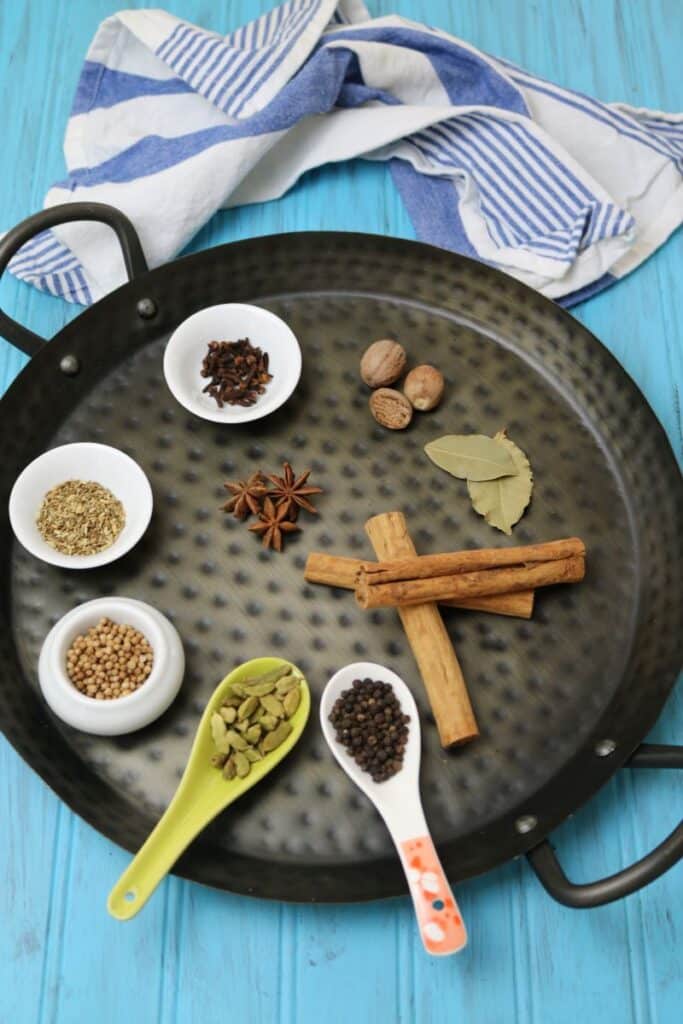
How to Make Garam Masala Spice Mix
Ready in just 10 minutes, first you will measure and toast the whole ingredients and then grind them together with the powdered ingredients. It’s really just that simple.
- Measure out the ingredients.
- Toast in a hot pan.
- Grind in a blender [paid link], food processor [paid link], or spice grinder.
- Sift to remove large pieces.
- Store in an air-tight jar or container for up to 6 months.
Can I Make Substitutions to the Recipe?
Yes, and we encourage that. There is no single way to prepare a garam masala spice mix, so you can alter it to fit your particular tastes. We feel any recipe is just a guideline and should be tweaked by you to achieve your desired flavor and spice level! Tweaking this recipe to your own individual tastes will pretty much guarantee that this is the best garam masala recipe ever! If you tweak this recipe, come back and let us know in the comments. We’d love to hear from you!
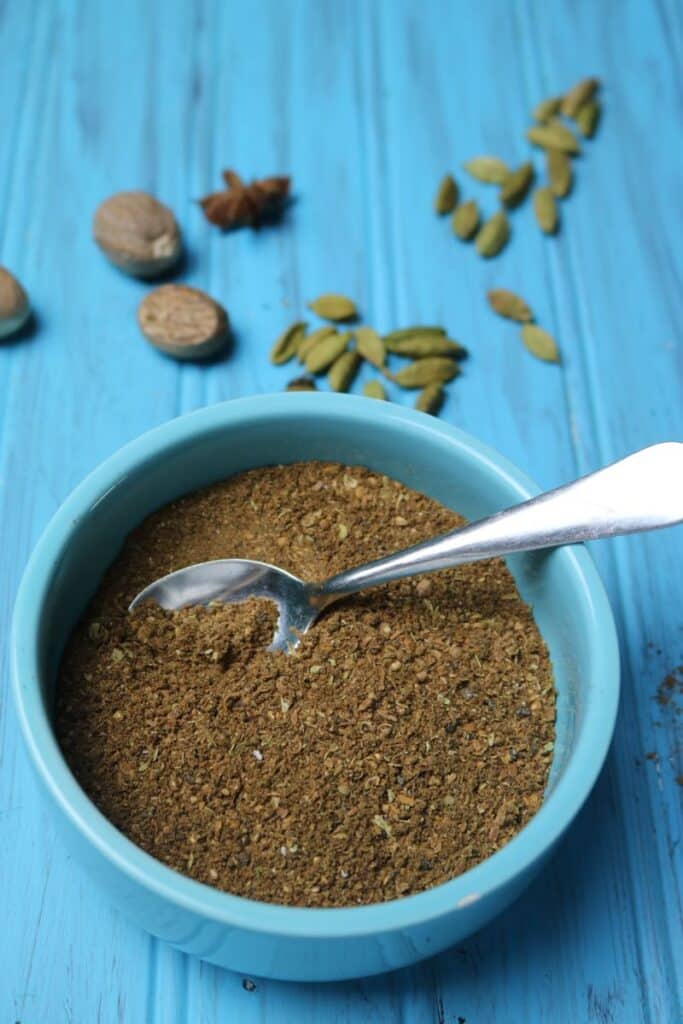
Common Substitutes for Garam Masala
Garam masala is a blend of ground spices used in many Indian dishes, and it adds warmth and depth to the flavors of a dish. Some common substitutes for garam masala include:
- Curry powder: Curry powder is a blend of spices that often includes coriander, cumin, turmeric, and other spices that are also found in garam masala. While the exact composition of curry powder varies, it can be used as a substitute for garam masala in a pinch.
- Cumin and coriander: These two spices are often used together in Indian cooking and can be a good substitute for garam masala. Toast them in a pan before grinding them to bring out their flavor.
- Allspice: Allspice is a spice made from the dried berries of the allspice tree, and it has a warm, slightly sweet flavor. While it is not traditionally used in Indian cooking, it can be used as a substitute for garam masala.
- Pumpkin pie spice: Pumpkin pie spice is a blend of cinnamon, ginger, nutmeg, and allspice, and it can be used as a substitute for garam masala. It has a sweet flavor, so it may not be the best substitute for savory dishes.
- Ras el hanout: Ras el hanout is a North African spice blend that typically includes cinnamon, coriander, cumin, ginger, and other spices. While it is not the same as garam masala, it can add a similar depth of flavor to a dish.
- Chinese five-spice powder: Chinese five-spice powder is a blend of cinnamon, star anise, cloves, fennel, and Szechuan peppercorns. While it is not traditionally used in Indian cooking, it can be used as a substitute for garam masala in some dishes.
It’s important to note that these substitutes may not give the exact same flavor profile as garam masala, but they can be used to add warmth and depth to a dish.
How long does DIY Garam Masala Last?
The shelf life of homemade garam masala can vary depending on several factors such as the quality of the ingredients used, how it is stored, and the humidity level in your area. In general, homemade garam masala should last for about 6 to 12 months if stored properly.
To ensure the longest shelf life of your homemade garam masala, store it in an airtight container in a cool, dry place away from direct sunlight. It’s also a good idea to label the container with the date it was made so you can keep track of its freshness.
Over time, the potency and flavor of the spices in garam masala will decrease, so it’s a good idea to periodically taste and smell the blend to ensure it is still fresh. If the aroma and flavor have diminished, it’s time to make a fresh batch.
Is this Garam Masala Gluten-Free?
Garam masala is typically gluten-free, as it is made from a blend of ground spices, which do not typically contain gluten. However, it’s important to check the label of any pre-packaged garam masala blends, as some may contain fillers or additives that could potentially include gluten.
If you’re making your own garam masala blend at home, be sure to use only gluten-free spices and store them in a clean, dry container. Avoid using any spice blends that contain wheat or other gluten-containing grains, such as barley or rye.
If you have celiac disease or are gluten intolerant, it’s always best to double-check the ingredients and manufacturing processes of any packaged spices or spice blends you plan to use, as cross-contamination is always a possibility. When in doubt, look for certified gluten-free products or make your own blend at home using pure, unadulterated spices.
Serving Ideas
Garam Masala Powder adds a warm, earthy flavor to dishes. Here are some serving ideas for garam masala powder:
- Add it to curries: Garam masala is an essential ingredient in many Indian curries. Simply sprinkle some garam masala powder into your curry towards the end of the cooking process to enhance its flavor.
- Use it as a rub: Mix garam masala powder with salt and any other spices you like, and use it as a rub for chicken, fish, or meat before grilling or roasting.
- Sprinkle it on vegetables: Garam masala pairs well with roasted or sautéed vegetables. Toss your vegetables in oil, salt, and garam masala powder, and roast them in the oven or cook them on the stovetop.
- Use it in soups: Garam masala can add depth and warmth to soups and stews. Add a pinch of garam masala powder to lentil soup or vegetable soup for a delicious flavor boost.
- Season rice dishes: Add garam masala powder to rice dishes like biryani or pulao for a fragrant and flavorful twist.
- Sprinkle on snacks: Add a pinch of garam masala powder to popcorn, nuts, or roasted chickpeas [paid link] for a savory snack.
Remember, a little goes a long way with garam masala, so start with a small amount and adjust to taste.
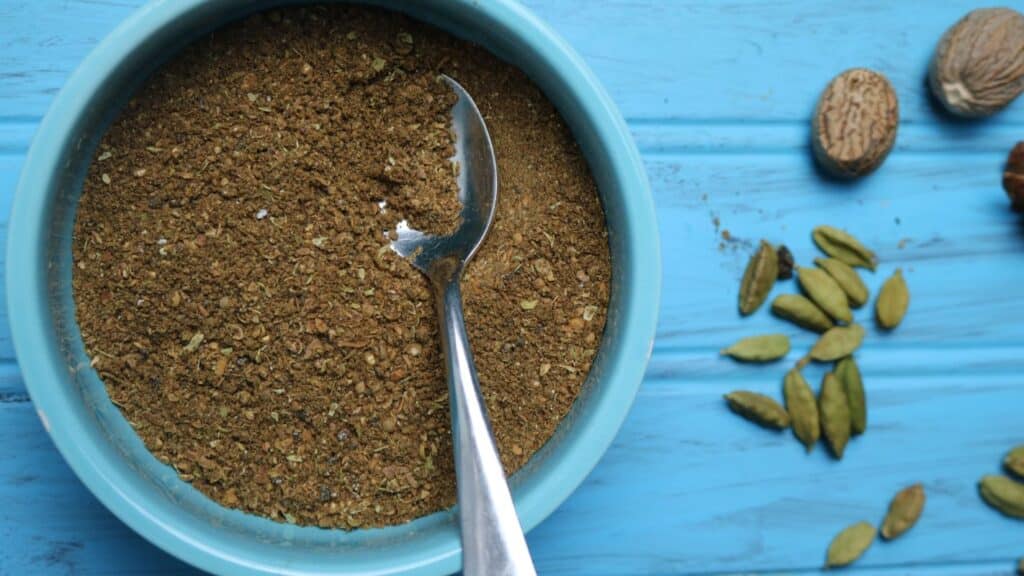

Disclosure, Copyright & Privacy Policy
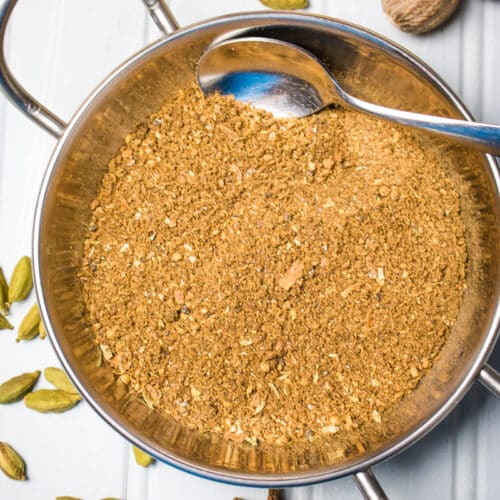
Garam Masala Powder
Equipment
- Spice grinder or food processor [paid link]
- Skillet (for toasting)
Ingredients
Basic Spices
- 3 tbsp Whole Black peppercorns
- 4 tsp Green Cardamom pods whole
- 2 tbsp Coriander Seeds heaping
- 2 whole Star Anise
- 1 tsp Ground Cumin
- 1 Cinnamon Stick 3-inch piece
Optional Spices
- 2 whole Bay leaves
- 1 tsp Whole cloves
- 1/2 tsp Nutmeg
- 1 tsp Fennel Seeds
- 1 tsp Black Cardamom Seeds
Instructions
- Place whole spices in a dry skillet and toast over medium heat for about 2 to 5 minutes. stirring frequently. The fragrance of the spices will bloom as essential oils are released. Be careful not to scorch the spices as they will become bitter tasting.
- Transfer toasted spices to the bowl of a food processor [paid link] or spice grinder and allow to cool about 5 minutes before processing.
- Once the spices have cooled, blend them along with any reserved powdered spices. Grind into a fine powder, about 3 minutes.
- It may be necessary to sift the mix of any larger pieces. Do this with some cheesecloth [paid link] that has been layered or a fine-mesh sieve. This step is optional.
- Store in an air-tight container or glass jar for up to 6 months.
Notes
- You can adjust the quantities of the spices to suit your personal taste. Some variations may include fennel seeds, bay leaves, or star anise.
